|
 Gliophorus graminicolor Gliophorus graminicolor
SynonymsGliophorus pallidus
Hygrocybe graminicolor
Hygrocybe pallida
BiostatusPresent in region - Indigenous. Non endemic
Images (click to enlarge)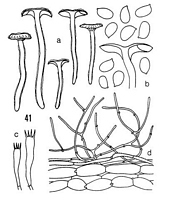
Caption: Gliophorus graminicolor Hk. (type): a. carpophores. - b. spores. - c. basidia. - d. cuticle | 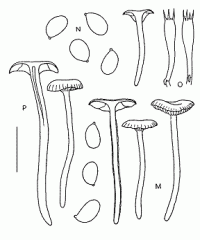
Caption: Fig. 29 Gliophorus graminicolor Horak (M-O: PDD 27096, type):
M. basidiomes. N. spores. O. basidia. (ZT 67/177): P. basidiomes. | 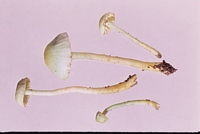
Owner: Herb. PDD | 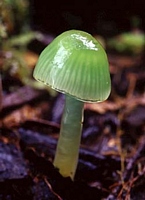
Caption: Gliophorus graminicolor
Owner: Kaimai Bush | 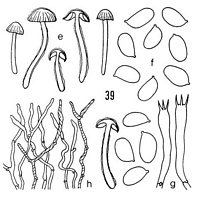
Caption: Gliophorus graminicolor
Owner: Kaimai Bush | 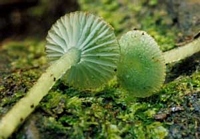
Caption: Gliophorus graminicolor
Owner: Kaimai Bush | 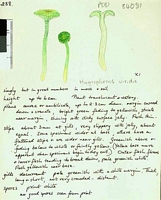
Caption: Watercolour
Owner: G.M. Taylor | 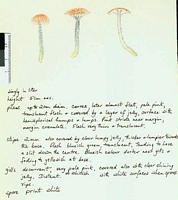
Caption: Watercolour
Owner: G.M. Taylor | 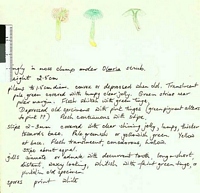
Caption: Watercolour
Owner: G.M. Taylor | 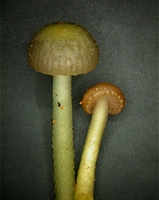
Caption: FUNNZ: 2006/0386, See public note for more information
Owner: FUNNZ | 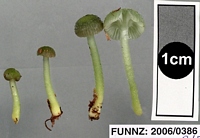
Caption: FUNNZ: 2006/0386, See public note for more information
Owner: FUNNZ | 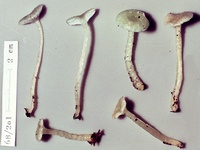
Caption: ZT68-201 , Holotype
Owner: E. Horak: © Creative Commons Attribution-Noncommercial 3.0 New Zealand | 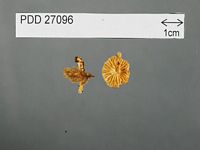
Caption: Drid type specimen
Owner: Herb PDD | 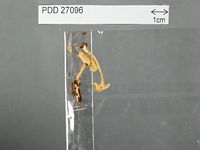
Caption: Dried type specimen
Owner: Herb PDD | 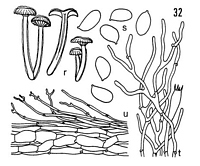
Caption: Gliophorus pallidus Hk. (type): r. carpophores. - s. spores. - t. cheilocystidia. - u. cuticle | 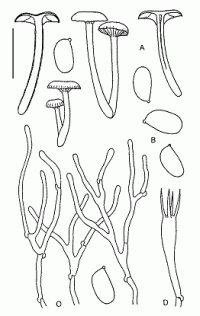
Caption: Fig. 26 Gliophorus pallidus Horak (A-C: PDD 27090, type): A.
basidiomes. B. spores. C. cheilocystidia (x2000). ZT 592): D. basidium. | 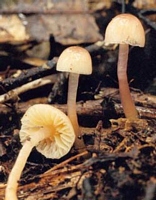
Caption: Gliophorus pallidus
Owner: Kaimai Bush | 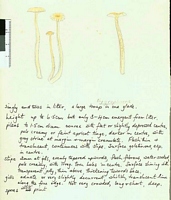
Caption: Watercolour
Owner: G.M. Taylor | 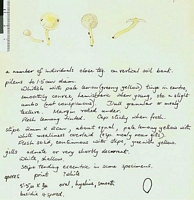
Caption: Watercolour
Owner: G.M. Taylor | 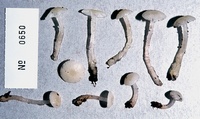
Caption: ZT0650
Owner: E. Horak: © Creative Commons Attribution-Noncommercial 3.0 New Zealand | 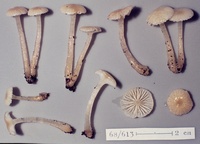
Caption: ZT68-613 , Holotype
Owner: E. Horak: © Creative Commons Attribution-Noncommercial 3.0 New Zealand | 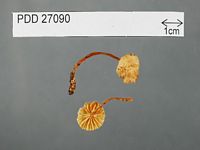
Caption: Dried type specimen
Owner: Herb PDD | 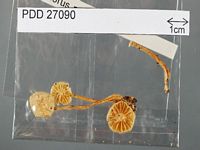
Caption: Dried type specimen
Owner: Herb PDD |
Article: Horak, E. (1990). Monograph of the New Zealand Hygrophoraceae (Agaricales). New Zealand Journal of Botany 28(3): 255-306 (http://www.rsnz.org/publish/abstracts.php).
Description: Pileus - 40 mm, hemispherical later becoming planoconvex to subumbilicate;
grass green or moss green, paler towards translucently striate margin; glutinous.
- Lamellae 9-14 (1-3) distant, broadly adnate to subdecurrent;, white with green
tinge, with grey coloured, gelatinised edges. -Stipe 25-70 x 2-5 mm, cylindrical.
equal; apex concolorous with pileus, whitish or orange towards base; glutinous,
glabrous when dry, fistulose, single. –Context greenish turning pink on drying.
- Odour and taste unpleasant, like burnt hair. - Chemical reactions on pileus:
KOH, HCI - negative.
Spores 4.5-6 x 3-4 um ovoid. - Basidia 25-35 x 5-6 um, 4-spored. - Cheilocystidia
conspicuous, composed of cylindrical hyphae (1-3 um diam.) with strongly gelatinised
membranes. - Pileipellis an ixocutis of cylindrical, hyaline hyphae (1-5 um
diam.), membranes strongly gelatinised, with plasmatic pigment; clamp connections
present (Pl. 1, Fig. 6).
Habitat:
Distribution: DISTRIBUTION: NZ: (WL, SL).
Article: Horak, E. (1973). Fungi Agaricini Novazelandiae I-V. Beihefte zur Nova Hedwigia 43: 200 p.
Description: Pileus 10-40 mm diam., hemispherical later becoming plano-convex to subumbilicate, grass green or moss green, paler towards the translucidly striated margin, glutinous. Lamellae broadly adnate to decurrent, whitish-greenish, with grey coloured gelatinized gill edge, distant. Stipe 25-70 x 2-5 mm, cylindric, apex concolorous with pileus, whitish to orange towards the base, glutinous throughout its entire length, glabrous, fistulose, single. Context greenish, turning pink on drying. Taste and odor unpleasant, like burnt hair. Chemical reactions on pileus: KOH and HCl - negative.
Spores 4.5-6 x 3-4 µm, ovoid, smooth, inamyloid. Basidia 25-35 x 5-6 µm, 4-spored. Cheilocystidia conspicuous, forming a sterile gill edge, hyphae (1-3 µm diam.) with strongly gelatinized membranes. Cuticle consisting of cylindric, gelatinized, hyaline hyphae (1-5 µm diam.) forming an ixotrichodermium. Clamp connections present.
Habitat: In soil amongst mosses under Nothofagus, Dacrydium, Podocarpus, Metrosideros, etc. New Zealand.
Notes: For discussion see G. viridis (Stev.) (39).
Article: Horak, E. (1990). Monograph of the New Zealand Hygrophoraceae (Agaricales). New Zealand Journal of Botany 28(3): 255-306 (http://www.rsnz.org/publish/abstracts.php).
Description: Pileus -20 mm, convex becoming plane or umbilicate, depressed at centre in
aged basidiomes; whitish to pale argillaceous later turning pale brown with
orange-yellow tints; glutinous, translucently striate at membranaceous margin.
- Lamellae 6-14 (1-3) broadly adnate to decurrent, arcuate; whitish turning
pale orange, edges with hyaline, gelatinous thread, concolorous, - Stipe 15-40
x 2-3 mm, cylindrical, equal or swollen at base; whitish (to pinkish), with
ochraceous tints towards base; glutinous, solid, frequently caespitose. - Context
whitish, waxy. - Odour and taste not distinctive, occasionally unpleasant. -
Chemical reactions on pileus: KOH - negative.
Spores 6-7.5 x 3.4-4 um, ellipsoid.- Basidia 34-40 x 4 -6 um, 4-spored. - Cheilocystidia
composed of erect, branched hyphae (2-5 um diam.) with strongly gelatinised
membranes, forming the gelatinous thread at edges. -Pileipellis an ixocutis
of repent to interwoven, cylindrical, gelatinised hyphae (1-5 um diam.), with
rounded, occasionally irregularly branched or forked tips; clamp connections
present (Pl. 1, Fig. 6).
ECOLOGY: Scattered; saprobic on soil among litter or on very rotten wood in
Nothofagus and broadleaved conifer forests, occasionally also on decayed trunks
of tree fems. May-June.
Distribution: DISTRIBUTION: NZ (NA, G).
Article: Horak, E. (1973). Fungi Agaricini Novazelandiae I-V. Beihefte zur Nova Hedwigia 43: 200 p.
Description: Pileus 5-20 mm diam., convex becoming plane or umbilicate, creamy or beige later turning light brownish with orange tinge, glutinous, translucidly striated at the membranaceous margin. Lamellae broadly adnate to decurrent, whitish, turning pallid orange, with hyaline, gelatinous thread at the gill edge. Stipe 15-40 x 2-3 mm, cylindric, whitish or pinkish, towards the base with ochraceous tints, glutinous throughout its entire length, solid, frequently in clusters. Context whitish. Taste and odor not distinctive. Chemical reactions on pileus: KOH - negative.
Spores 6.5-7.5 x 3.5-4 µm, ellipsoid, smooth, inamyloid. Basidia 34-36 x 6 µm, 4-spored. Cheilocystidia consisting of branched hyphae (2-5 µm diam.) with strongly gelatinized membranes, forming the glutinous thread at the gill edge. Cuticle consisting of repent to suberect, gelatinized hyphae (1-5µm diam.), free ends irregularly branched or coralloid, forming an ixocutis. Clamp connections present.
Habitat: In soil under Nothofagus (N. fusca, N. menziesii), Dacrydium cupressinum, Elaeocarpus, etc. New Zealand.
Notes: This is a characteristic fungus from which a painting is found on the back cover of Taylor's book (1970; between H. viridis and H. conicus).
|